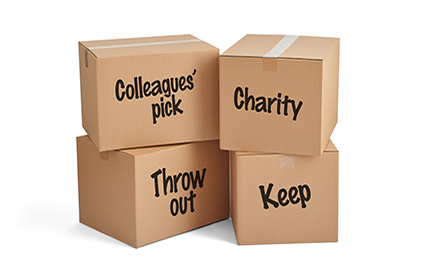Page Content
Teachers can’t take everything home when they retire. Walking out on the last day with just one box requires starting months in advance and doing a little every day.
Photo: Bromley Chamberlain
On your last day, walk out carrying just one container
 The idea of retiring is fraught with mixed emotions and uncertainty. There are year-end parties and celebrations, explanations, second thoughts, daydreams, notices to friends and family and … packing up your classroom.
The idea of retiring is fraught with mixed emotions and uncertainty. There are year-end parties and celebrations, explanations, second thoughts, daydreams, notices to friends and family and … packing up your classroom.
Teachers are accumulators, and you likely have a few boxes and bins filled with invaluable, pre-Cambrian
teaching materials that have contributed to your great success as a unique teacher. An elementary teacher may have three or four times the accumulated paraphernalia, for obvious reasons.
Unless you intend to redecorate your home in “my early classroom” décor, you likely don’t need to keep anything from your classroom. You acquired, stored and kept your treasures entirely for use in your teaching. Even furniture you brought in to make your room cozy and comfortable for the students may have to be left or discarded if no one else can make use of it. The custodian will help you with this task.
Here’s the challenge: get 40 years of collected resources condensed into one moving box. It can be done. My first retirement activity was to move into our 15th home, and movers were paid by the hour. Why don’t you pretend that is your situation as you move from a practising teacher to a retired one? Here are some suggestions to help you leave your classroom absolutely bare and ready for the next educator.
- Imagine hiking in a national park where you are urged to leave it as you found it (or better). Minimize that footprint and let the new teacher start with that “clean slate” with their one box containing a laptop computer and three USB sticks.
- Anything that was purchased under the school budget must be left at the school. If it is past its due date, speak to administration about permission to throw out the item.
- Anything that looks like it could cause a fatal or communicable disease must be thrown away.
- Get a truck to dispose of anything that won’t fit in the school dumpster.
- Start early. Place your stored boxes and items out on tables in your classroom or office specifically for that purpose. Tell the students you are decluttering — hands off please! You can’t take everything home. The work has to be done where the material is already. Just do a little every day. This is a very personal journey and no one else can help you at this point.
When you see what you have, begin sorting. Make labels and place them on the boxes or bins you already have. Don’t bring in any more boxes! Take your time and change your mind as much as you want but, at the end, only one box is going home with you. Empty the first box and use it to sort items from the other boxes. Don’t make them too heavy for you to carry. Dump the “throw out” box as it gets full and overcome the urge to go dumpster diving.

To make full use of the four-box system, decide in advance what you’re going to do with the contents of each container and, most importantly, set predetermined dates.
Photo: Stock/Ryan Majeau
You are smart, and I bet you get the hang of this now. You have been taking your personal books, films, photos and items home each day, a little at a time. If your colleagues haven’t removed what they want, set a deadline when the “stuff” will no longer be available. What is left will be sorted into the charity boxes to be dropped off on another determined date. The “throw out” box is empty and you will finish filling the “keep” box when you clear your desk.
If there is material that you have not already digitized, scan or copy your best material and save all that in a binder or on a USB stick just in case.
Make sure that you have cleaned off the information from the computer you used regularly.
Take any student documents or records to the office. Destroy personal notes and information as required by law.
You have so many other end-of-year tasks to take care of, you do not have any more time to invest in this purging exercise. With what’s left, have a “for-free garage sale.”
Your students get first dibs on the merchandise. Can you imagine the joy of that student who always wanted that book, set of blocks, piece of music, cage for the iguana or that 20-year-old spider plant that survived the freeze of 2010? Colleagues, parents and friends get to check through the remaining items. One person’s junk is someone else’s treasure.
Finally, your last day as a full-time, classroom teacher arrives. Evaluations are in, report cards completed and farewell events and class trips were successful. Take that last box of “keeps” to your car and saunter back into the building ready for your fellow teachers to honour you and wish you the best. You will have a heart full of memories and one box of stuff to put away. Congratulations and welcome to retirement.
Iona Robertson is a substitute teacher with Parkland School Division and president of the Parkland Area Retired Teachers’ Association.
